Balkans: Difference between revisions
m robot Adding: gag:Balkan |
m →Jewish communities of the Balkans: spelling edit |
||
| Line 236: | Line 236: | ||
The Jewish communities of the Balkans were some of the oldest in Europe and date back to ancient times as well as having received a large influx of [[Sephardic]] Jews and later [[Ashkenazi]] Jews. [[Jews in Slovenia|In Slovenia]], there were Jewish immigrants dating back to Roman times pre-dating the 6th Century settlement of the region by the Slavic peoples.<ref>Jews of Yugoslavia 1941–1945 Victims of Genocide and Freedom Fighters, Jasa Romano</ref> In [[Bosnia and Herzegovina]], the tiny Jewish community is 90% [[Sephardic]] and [[Judeo-Spanish|Ladino]] is still spoken among the elderly. The Sephardi Jewish cemetery in [[Sarajevo]] has tombstones of a unique shape, inscribed in ancient Ladino.<ref>[http://www.eurojewcong.org/ejc/news.php?id_article=59 European Jewish Congress - Bosnia-Herzegovina], Accessed July 15, 2008.</ref> |
The Jewish communities of the Balkans were some of the oldest in Europe and date back to ancient times as well as having received a large influx of [[Sephardic]] Jews and later [[Ashkenazi]] Jews. [[Jews in Slovenia|In Slovenia]], there were Jewish immigrants dating back to Roman times pre-dating the 6th Century settlement of the region by the Slavic peoples.<ref>Jews of Yugoslavia 1941–1945 Victims of Genocide and Freedom Fighters, Jasa Romano</ref> In [[Bosnia and Herzegovina]], the tiny Jewish community is 90% [[Sephardic]] and [[Judeo-Spanish|Ladino]] is still spoken among the elderly. The Sephardi Jewish cemetery in [[Sarajevo]] has tombstones of a unique shape, inscribed in ancient Ladino.<ref>[http://www.eurojewcong.org/ejc/news.php?id_article=59 European Jewish Congress - Bosnia-Herzegovina], Accessed July 15, 2008.</ref> |
||
Sephardi Jews used to have a large presence in the city of [[Thessaloniki]], and by 1900, some 80,000, or more than half of the population, were Jews.<ref>"[http://www.jewishvirtuallibrary.org/jsource/vjw/Greece.html Greece]". [[Jewish Virtual Library]].</ref> However the Jewish communities in the Balkans suffered immensely during [[World War II]] and the vast majority were killed during the [[The Holocaust|Holocaust]]. However an exception were the [[Bulgarian Jews]] many of whom were saved by [[Boris III of Bulgaria]], who countered [[Adolf Hitler]] for their leading to [[concentration camps]]. Most of the |
Sephardi Jews used to have a large presence in the city of [[Thessaloniki]], and by 1900, some 80,000, or more than half of the population, were Jews.<ref>"[http://www.jewishvirtuallibrary.org/jsource/vjw/Greece.html Greece]". [[Jewish Virtual Library]].</ref> However the Jewish communities in the Balkans suffered immensely during [[World War II]] and the vast majority were killed during the [[The Holocaust|Holocaust]]. However an exception were the [[Bulgarian Jews]] many of whom were saved by [[Boris III of Bulgaria]], who countered [[Adolf Hitler]] for their leading to [[concentration camps]]. Most of the remaining populations emigrated to [[Israel]] and elsewhere. |
||
==See also== |
==See also== |
||
Revision as of 10:32, 20 November 2010
This article needs additional citations for verification. (August 2010) |
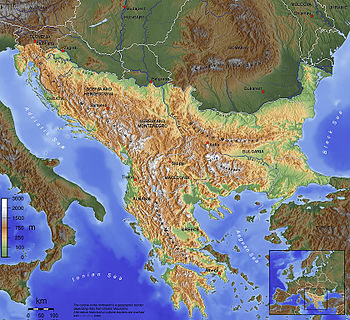
The Balkans (often referred to as the Balkan Peninsula, although the two are not coterminous) is a geopolitical and cultural region of southeastern Europe. The region takes its name from the Balkan Mountains, which run through the centre of Bulgaria into eastern Serbia. The region has a combined area of 550,000 km2 (212,000 sq mi) and a population of 55 million people.[citation needed]
"Balkan" comes from a Turkish word meaning "a chain of wooded mountains".[1] The ancient Greek name for the Balkan Peninsula was the "Peninsula of Haemus” ( Χερσόνησος τοῦ Αἵμου, Chersónēsos tou Haímou). Romans considered the Rhodope Mountains to be the northern limit of the Peninsula of Haemus and the same limit applied approximately to the border between Greek and Latin use in the region (this was later called Jireček Line[2]). The Balkans are also referred to as Southeastern Europe.
Definitions and boundaries
The Balkan Peninsula

The Balkan Peninsula may be defined as an area of southeastern Europe surrounded by water on three sides: the Adriatic Sea to the west, the Mediterranean Sea (including the Ionian and Aegean seas) to the south and the Black Sea to the east. Its northern boundary is often given as the Danube, Sava and Kupa/Kolpa rivers.[3]
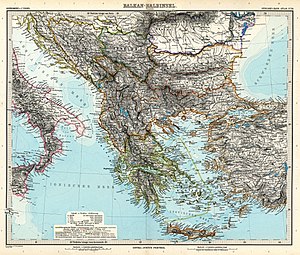
Countries which are geographically fully located within the Balkan peninsula:
 Albania
Albania Bosnia and Herzegovina
Bosnia and Herzegovina Bulgaria
Bulgaria Greece
Greece Kosovo (partially recognized[4])
Kosovo (partially recognized[4]) North Macedonia
North Macedonia Montenegro
Montenegro
Countries which are significantly located on the peninsula:
Countries which are located mostly outside the peninsula:
 Romania (Northern Dobruja)
Romania (Northern Dobruja) Turkey (Eastern Thrace)
Turkey (Eastern Thrace) Italy (Province of Trieste)
Italy (Province of Trieste) Slovenia (the South)
Slovenia (the South)
The Balkans
The term "The Balkans" covers not only those countries which lie within the boundaries of the "Balkan Peninsula", but may also include Slovenia, and Romania.[3] Slovenia, which was part of Yugoslavia from 1919 to 1991, lies partially north of the Danube-Sava line and therefore outside the Peninsula, but prior to 1991 the whole of Yugoslavia was considered to be part of the Balkans.[5] The father of the term "The Balkans" August Zeune defined it in 1808 to describe areas that remained under Turkish rule after 1699.
In most of the English-speaking world, the countries commonly included in the Balkan region are:[6]
 Albania
Albania Bosnia and Herzegovina
Bosnia and Herzegovina Bulgaria
Bulgaria Croatia
Croatia Greece
Greece Kosovo (partially recognized[4])
Kosovo (partially recognized[4]) North Macedonia
North Macedonia Montenegro
Montenegro Serbia
Serbia
Other countries sometimes included are:
Italy until World War II included Istria and some Dalmatian areas (like Zara, known as Zadar), but now it has only the small area of the Province of Trieste inside the Balkan region. However, Trieste and Istria are usually considered not part of the Balkans by Italian geographers, due to a definition of the Balkans that limits its western border to the Kupa river.[7]
Etymology and evolving meaning
The region takes its name from the Stara Planina mountain range on the border between Bulgaria and Serbia, commonly known as the Balkan Mountains (from the Turkish [balkan] Error: {{Lang}}: text has italic markup (help) meaning "a chain of wooded mountains").[1] The name is still preserved in Central Asia where there exist the Balkan Mountains[8] and the Balkan Province of Turkmenistan. On a larger scale, the mountains are only one part of a long continuous chain of mountains crossing the region in the form of a reversed letter S, from the Carpathians south to the Balkan range proper, before marching away east into Anatolian Turkey. On the west coast, an offshoot of the Dinaric Alps follows the coast south through Dalmatia and Albania, crosses Greece and continues into the sea in the form of various islands.
The first attested time the name "Balkan" was used in the West for the mountain range in Bulgaria was in a letter sent in 1490 to Pope Innocent VIII by Buonaccorsi Callimaco, an Italian humanist, writer and diplomat.[9] English traveler John Morritt introduced this term into the English literature at the end of the 18th century, and other authors started applying the name to the wider area between the Adriatic and the Black Sea. The concept of the “Balkan peninsula” was created by the German geographer August Zeune in 1808.[10]
As time passed, the term gradually obtained political connotations far from its initial geographic meaning, arising from political changes from the late 19th century to the creation of post-World War I Yugoslavia (initially the Kingdom of Serbs, Croats and Slovenes). Zeune's goal was to have a geographical parallel term to the Italic and Iberian Peninsula, and seemingly nothing more. The gradually acquired political connotations are newer, and, to a large extent, due to oscillating political circumstances.
The term Balkans is generally used to describe areas that remained under Turkish rule after 1699, namely: Bulgaria, Serbia (except for Vojvodina), Macedonia, Thrace, Albania, Valahia, Moldavia, Epirus, Bosnia and Herzegovina, Montenegro (except for the Boka Bay and Budva), central Greece and the Peloponnese. Vojvodina and Transylvania, it is argued, do not belong to Balkans. After the split of Yugoslavia beginning in June 1991, the term 'Balkans' again received a negative meaning, even in casual usage (see Balkanization). Over the last decade, in the wake of the former Yugoslav split, many Slovenians and Croatians, as well as Serbs of Vojvodina have attempted to reject their label as 'Balkan nations'.[11]

This is in part due to the pejorative connotation of the term 'Balkans' in the 1990s, and continuation of this meaning until now. Today, the term 'Southeast Europe' is preferred or, in the case of Slovenia and Croatia, 'Central Europe' and Greece has almost exclusively been regarded and referred to as a 'Southern European' country.
Southeastern Europe
Because of the negative connotations of the term "Balkan", the use of the term Southeastern Europe has become increasingly popular.[12] A European Union initiative of 1999 is called the Stability Pact for South Eastern Europe, and the online newspaper Balkan Times renamed itself Southeast European Times in 2003.
Western Balkans
European Union institutions and member states define the "Western Balkans" as Albania and the former Yugoslavia, minus Slovenia.[13] The European Bank for Reconstruction and Development uses "Western Balkans" to refer to the above states, minus Croatia.[14] Today Western Balkans is more of a political than geographic definition for the region of Southeast Europe that is not yet in the European Union.
Regional organizations
 |
 members observers supporting partners |
 members observers |
 members observers |
See also the Black Sea Regional organizations
Nature and natural resources
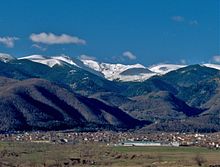
Most of the area is covered by mountain ranges running from north-west to south-east. The main ranges are the Dinaric Alps in Slovenia, Croatia and Bosnia, the Šar massif which spreads from Albania to Macedonia and the Pindus range, spanning from southern Albania into central Greece. In Bulgaria there are ranges running from east to west: the Balkan mountains and the Rhodope mountains at the border with Greece. The highest mountain of the region is Rila in Bulgaria, with Musala at 2925 m, with Mount Olympus in Greece, the throne of Zeus, being second at 2919 m and Vihren in Bulgaria being the third at 2914 m.
On the Adriatic and Aegean coasts the climate is Mediterranean, on the Black Sea coast the climate is humid subtropical and oceanic, and in the inland it is moderate continental. In the northern part of the peninsula and on the mountains, winters are frosty and snowy, while summers are hot and dry. In the southern part winters are milder.
During the centuries many woods have been cut down and replaced with bush. In the southern part and on the coast there is evergreen vegetation. In the inland there are woods typical of Central Europe (oak and beech, and in the mountains, spruce, fir and pine). The tree line in the mountains lies at the height of 1800–2300 m.
The soils are generally poor, except on the plains where areas with natural grass, fertile soils and warm summers provide an opportunity for tillage. Elsewhere, land cultivation is mostly unsuccessful because of the mountains, hot summers and poor soils, although certain cultures such as olives and grapes flourish.
Resources of energy are scarce, except in Kosovo, where considerable coal, lead, zinc, chromium, silver deposits are located.[15] Other deposits of coal, especially in Romania, Bulgaria, Serbia and Bosnia also exist. Lignite deposits are widespread in Greece. Petroleum is most notably present in Romania, although scarce reserves exist in Greece, Serbia, Albania and Croatia. Natural gas deposits are scarce. Hydropower stations are largely used in energetics.
Metal ores are more usual than other raw materials. Iron ore is rare but in some countries there is a considerable amount of copper, zinc, tin, chromite, manganese, magnesite and bauxite. Some metals are exported.
History and geopolitical significance


The Balkan region was the first area of Europe to experience the arrival of farming cultures in the Neolithic era. The practices of growing grain and raising livestock arrived in the Balkans from the Fertile Crescent by way of Anatolia, and spread west and north into Pannonia and Central Europe.
The identity of the Balkans is dominated by its geographical position; historically the area was known as a crossroads of various cultures. It has been a juncture between the Latin and Greek bodies of the Roman Empire, the destination of a massive influx of pagan Slavs, an area where Orthodox and Catholic Christianity met, as well as the meeting point between Islam and Christianity.
In pre-classical and classical antiquity, this region was home to Greeks, Illyrians, Paeonians, Thracians, Dacians and other ancient groups. Later the Roman Empire conquered most of the region and spread Roman culture and the Latin language but significant parts still remained under classical Greek influence. The Slavs arrived in the 6th century and began assimilating and displacing the older inhabitants of the northern and central Balkans.[16] During the Middle Ages, the Balkans became the stage for a series of wars between the Byzantine, Bulgarian and Serbian Empires.
By the end of the 16th century, the Ottoman Empire had become the controlling force in the region after expanding from Anatolia through Thrace to the Balkans. Many people in the Balkans and Carpathians place their greatest folk heroes in the era of either the onslaught or the retreat of the Ottoman Empire. As examples, for Croats, Nikola Šubić Zrinski and Petar Kružić; for Greeks Constantine XI Palaiologos and Kolokotronis for Serbs, Miloš Obilić and Tzar Lazar; for Albanians, Gjergj Kastrioti Skanderbeg; for ethnic Macedonians, Nikola Karev; for Bosniaks, Husein Gradaščević; and for Bulgarians, Vasil Levski, Georgi Sava Rakovski and Hristo Botev. In the past several centuries, because of the frequent Ottoman wars in Europe fought in and around the Balkans, and the comparative Ottoman isolation from the mainstream of economic advance (reflecting the shift of Europe's commercial and political centre of gravity towards the Atlantic), the Balkans has been the least developed part of Europe. The population of the Balkans, according to one estimate, fell from a high of 8 millions in the late 16th century to only 3 million by the mid-eighteenth.[17]

The Balkan nations gained independence in the 19th century (Greece in 1829, Serbia in 1833, Bulgaria and Montenegro in 1878).
20th century
In 1912–1913 the First Balkan War broke out when the Christian nations, having large populations under Ottoman rule, united in an alliance against the Turks and after a five months war essentially terminated the Turks' presence in Europe after five centuries. Two months after the end of the common war, a Second Balkan War broke out when Bulgaria dissatisfied from its share, attacked its allies Serbia and Greece. The Serbs and the Greeks repelled them and after the Greek army invaded Bulgaria following by a Romanian intervention, Bulgaria collapsed. The Turks used the favourable opportunity to recapture Eastern Thrace, establishing its new western borders that stand until today.
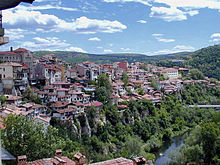
The First World War was sparked in the Balkans in 1914 when a Black hand revolutionary organization with predominately Serbian and pro Yugoslav oriented members assassinated in Bosnia and Herzegovina's capital Sarajevo the Austro-Hungarian heir Archduke Franz Ferdinand of Austria. That caused a war between the two countries which -through the existing chains of alliances- led to the First World War. The Ottoman empire soon joined the Central powers becoming one of the three empires participating in that alliance. The next year Bulgaria joined the Central Powers attacking Serbia which was successfully fighting Austro-Hungary to the north for a year. That led to Serbia's defeat and the intervention of the Entente in the Balkans which sent an expeditionary force to establish a new front, the third one of that war, which soon became also static. The participation of Greece in the war three years later, in 1918, on the part of the Entente finally altered the balance between the opponents leading to the collapse of the common German-Bulgarian front there which caused the exit of Bulgaria from the war, and in turn the collapse of the Austro-Hungarian Empire ending the First World War.[18]
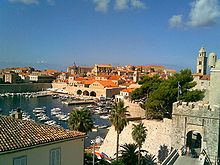
With the start of the Second World War all Balkan countries with the exception of Greece were allies of Germany having bilateral military agreements or being part of the Axis Pact. Fascist Italy expanded the war in Balkans by using its protectorate Albania to invade Greece. After repelling the attack the Greeks counterattacked invading Italy held Albania causing a Nazi Germany's intervention in the Balkans in order to help its ally.[19] Days before the German invasion a successful coup d'état in Belgrade by neutral military personnel sized the power.[20]
Although the new government reaffirmed Serbia's intentions to fulfil its obligations as member of the Axis,[21] Germany using its other two allied countries on the region, Bulgaria and Romania, invaded both Greece and Yugoslavia. Yugoslavia immediately disintegrated when the loyal to the Serbian King and the Croatian units, mutinied.[22] Greece resisted, but after two months fighting collapsed and occupied. The two countries partitioned between the three Axis allies, Bulgaria, Germany, and Italy, and two independent states, Croatia and Montenegro created.
During the occupation the population suffered considerable hardship due to ethnic cleansing policies, repression and starvation on which the population reacted by creating a mass resistance movement.[23] Together with the early and extremely heavy winter of that year (which caused hundreds of thousands deaths among the poorly fed population), the German invasion had disastrous effects in the timetable of the planned invasion in Russia causing a significant delay[24] which had key consequences to the route of the war.[25]
Finally at the end of 1944, the Soviets invaded Romania and Bulgaria while the Germans evacuated the Balkans. They left behind an economically ransacked through exploitation and largely ruined region, but by making use of the post-war separation of Germany into two independent entities, the German states succeeded to avoid legally, paying any reparations or repaying the forced taken loans to the occupied countries. The official Yugoslav post-war estimate of victims in Yugoslavia during World War II is 1,704,000. Subsequent data gathering in the 1980s by historians Vladimir Žerjavić and Bogoljub Kočović showed that the actual number of dead was about 1 million. Greece suffered more than 300,000 casualties during the occupation.
Cold War
During the Cold War, most of the countries on the Balkans were governed by communist governments. Greece became the first battleground of the emerging Cold War and finally remained the only non-Soviet country in the region, after having successfully dealt with a wild guerrilla war unleashed by the local communist party backed by the neighboring communist countries (Albania, Bulgaria and Yugoslavia) much in the same fashion as with Vietnam, causing a full scale civil war during 1944-49.
However, despite being under communist governments, Yugoslavia (1948) and Albania (1961) fell out with the Soviet Union. Yugoslavia, led by marshal Josip Broz Tito (1892–1980), first propped up then rejected the idea of merging with Bulgaria, and instead sought closer relations with the West, later even joining many third world countries in the Non-Aligned Movement. Albania on the other hand gravitated toward Communist China, later adopting an isolationist position.
As the only non-communist countries, Greece and Turkey were (and still are) part of NATO consisting the South-eastern wing of the alliance.
Post-Cold War
In the 1990s, the region was gravely affected by the civil war between the former Yugoslav republics broken out after Serbia's attempt to change the status of equality between the Yugoslav federated Republics to proportionate status. Other Republics didn't agree to the proposed change as unconstitutional and when Serbia tried to enforce it abandoned the federation. Serbia in turn declared the dissolution of the union as unconstitutional and the Yugoslavian army unsuccessfully tried to invade Croatia which together with Slovenia had declared independence. The Army eventually slowly withdrew from both nations by 1992 and in Croatia the war between the Croatian government and local Serbs would continue until 1995. In the ensuing 10 years armed confrontation, gradually all the other Republics declared independence. The long lasting civil war resulted in a United Nations intervention and NATO ground and air forces took action against the Serbian Army and guerilla groups in Bosnia and Herzegovina, Serbia and Kosovo.

From the dissolution of Yugoslavia six republics achieved international recognition as sovereign republics: Slovenia, Croatia, Bosnia, Macedonia, Montenegro and Serbia. Kosovo (according to the official Serbian policy still an internal autonomous region), currently under UN administration, declared independence in 2008. In July 2010, the International Court of Justice, after a UN General Assembly's request, opined that the declaration is legal under the international law. The international community is still divided on the matter and while the majority of the UN members do not recognize it as independent, most NATO and EU countries do. After the end of the wars a revolution broke in Belgrade and Slobodan Milošević, the Serbian communist leader (elected president between 1989–2000), was overthrown and handed for trail to the International Criminal Tribunal for crimes against the International Humanitarian Law during the civil wars. Ιn 2001 an Albanian uprising in Macedonia forced the country to give local autonomy to the ethnic Albanians in the areas where they predominate.
With the dissolution of Yugoslavia an issue emerged over the name under which the former (federated) republic of Macedonia would internationally be recognized, between the new country and Greece. Being the Macedonian part of Yugoslavia (see Vardar Macedonia), the federated Republic under the Yugoslav identity had the name Republic of Macedonia on which it declared its sovereignty in 1991. Greece, having a large region (see Macedonia (Greece)) also under the same name opposed to the usage of this name as an indication of a nationality. The issue is currently under (prologued) negotiations after a UN initiation.
Balkan countries control the direct land routes between Western Europe and South West Asia (Asia Minor and the Middle East). Since 2000, all Balkan countries are friendly towards the EU and the USA.
Greece has been a member of the European Union since 1981; Slovenia and Cyprus since 2004. Bulgaria and Romania joined in 2007. In 2005, the European Union decided to start accession negotiations with candidate countries; Croatia, Turkey, and Macedonia were accepted as candidates for European Union membership. As of April 2009,[26] Albania, Bulgaria, Croatia, Romania and Slovenia are also members of NATO. Bosnia and Herzegovina and what was then Serbia and Montenegro started negotiations with the EU over the Stabilization and Accession Agreements, although shortly after they started, negotiations with Serbia and Montenegro were suspended for lack of co-operation with the International Criminal Tribunal for the Former Yugoslavia. In 2008 Greece vetoed Macedonia's Nato membership bid over the Macedonia naming dispute between the two countries.
All other countries have expressed a desire to join the EU but at some date in the future.
The Balkans today is a very diverse ethno-linguistic region, being home to multiple Slavic, Romance, and Turkic languages, as well as Greek, Albanian and others. Through its history many other ethnic groups with their own languages lived in the area, among them Thracians, Illyrians, Romans, Pechenegs, Cumans, Avars, Celts and various Germanic tribes-folk.
Demographics


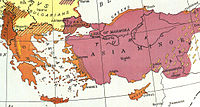
The population of countries of the region is:
| State | Population |
|---|---|
| 3,639,453[27] | |
| 4,613,414[28] | |
| 7,928,901[29] | |
| 4,489,409[30] | |
| 11,257,285[31] | |
| 2,180,686[32] | |
| 236,520 in Province of Trieste[33] | |
| 2,048,619[34] | |
| 620,145[35] | |
| 971,643[36] in Dobruja | |
| 7,334,935[37] excluding Kosovo | |
| 2,038,733[38] | |
| 10,691,518[39] in the European part |
Note that most of Slovenia and parts of Serbia and Croatia are not included in the Balkans, yet these parts are included in the population counts in the table.
The region's principal religions are Christianity (Eastern Orthodox and Roman Catholic) and Islam. A variety of different traditions of each faith are practiced, with each of the Eastern Orthodox countries having its own national church.
Eastern Orthodoxy is the principal religion in the following countries:
- Bulgaria (Bulgarian Orthodox Church)
- Greece (Church of Greece)
- Macedonia (Macedonian Orthodox Church)
- Montenegro (Serbian Orthodox Church)
- Romania (Romanian Orthodox Church)
- Serbia (Serbian Orthodox Church)
Roman Catholicism is the principal religion in the following countries:
- Croatia (87.83% Catholics (3 897 332); according to 2001 census official data)
- Slovenia (57.80% Catholics (1 135 626); according to 2002 census official data)
Islam is the principal religion in the following countries:
- Kosovo[4](absolute majority)
- Albania (relative majority)
- Bosnia and Herzegovina (relative majority)
- Turkey (absolute majority)
The following countries have significant minority religious groups of the following denominations:
- Albania: Orthodoxy, Catholicism
- Bosnia and Herzegovina: Eastern Orthodoxy (see Orthodoxy in Bosnia and Herzegovina), Catholicism
- Bulgaria: Islam
- Croatia: Orthodoxy
- Greece: Islam
- Macedonia: Islam
- Montenegro: Islam
- Serbia: Catholicism, Islam, Protestantism
- Romania: Catholicism, Protestantism
Jewish communities of the Balkans
The Jewish communities of the Balkans were some of the oldest in Europe and date back to ancient times as well as having received a large influx of Sephardic Jews and later Ashkenazi Jews. In Slovenia, there were Jewish immigrants dating back to Roman times pre-dating the 6th Century settlement of the region by the Slavic peoples.[40] In Bosnia and Herzegovina, the tiny Jewish community is 90% Sephardic and Ladino is still spoken among the elderly. The Sephardi Jewish cemetery in Sarajevo has tombstones of a unique shape, inscribed in ancient Ladino.[41]
Sephardi Jews used to have a large presence in the city of Thessaloniki, and by 1900, some 80,000, or more than half of the population, were Jews.[42] However the Jewish communities in the Balkans suffered immensely during World War II and the vast majority were killed during the Holocaust. However an exception were the Bulgarian Jews many of whom were saved by Boris III of Bulgaria, who countered Adolf Hitler for their leading to concentration camps. Most of the remaining populations emigrated to Israel and elsewhere.
See also
Notes
- ^ a b Balkan. Microsoft Corporation. Archived from the original on 2009-10-31. Retrieved 2008-03-31.
{{cite encyclopedia}}:|work=ignored (help); Unknown parameter|deadurl=ignored (|url-status=suggested) (help) - ^ Boundary between Greek and Latin
- ^ a b Jelavich, Barbara (1983). History of the Balkans: Eighteenth and nineteenth centuries. Cambridge University Press. p. 1. ISBN 978-0-521-27458-6.
{{cite book}}: Cite has empty unknown parameter:|coauthors=(help) - ^ a b c d Template:Kosovo-note
- ^ Tintero, Felipa L. World Geography Affected by World Upheavals. Goodwill Trading Co., Inc. p. 51. ISBN 9715740413.
{{cite book}}: Unknown parameter|coauthors=ignored (|author=suggested) (help) - ^ britannica.com; encarta.msn.com (Archived 2009-10-31); The Columbia Encyclopedia.
- ^ Istituto Geografico De Agostini, L'Enciclopedia Geografica - Vol.I - Italia, 2004, Ed. De Agostini p.78
- ^ "Balkhan Mountains". World Land Features Database. Land.WorldCityDB.com. Retrieved 2008-03-31.
- ^ Todorova, Maria (2009). Imagining the Balkans. Oxford University Press US. p. 22. ISBN 0-19-538786-4.
- ^ Pavic, Silvia (2000-11-22). "Some Thoughts About The Balkans". About, Inc. Retrieved 2008-03-31.
- ^ Lindstrom, Nicole (2003). "Between Europe and the Balkans: Mapping Slovenia and Croatia's 'Return to Europe' in the 1990s". Dialectical Anthropology. 27 (3–4): 313–329. doi:10.1023/B:DIAL.0000006189.45297.9e.
- ^ Bideleux, Robert (2007). A history of Eastern Europe. Taylor & Francis. p. 37. ISBN 978-0-415-36627-4.
{{cite book}}: Unknown parameter|coauthors=ignored (|author=suggested) (help) - ^ "Western Balkans: Enhancing the European Perspective" (PDF). Communication from the Commission to the European Parliament and the Council. 2008-03-05. Retrieved 2008-04-08.
- ^ Marjola Xhunga (2006-05-21). "Western Balkans Initiative launched". European Bank for Reconstruction and Development. Archived from the original on 2008-06-16. Retrieved 2008-05-17.
- ^ "Regions and territories: Kosovo". BBC News. 2009-11-20. Retrieved 2010-04-17.
- ^ "Twenty Years of Balkan Tangle". Mary Edith Durham (2007). p.125. ISBN 1434634264
- ^ "An economic and social history of the Ottoman Empire". Suraiya Faroqhi, Halil İnalcık, Donald Quataert (1997). Cambridge University Press. p.652. ISBN 0521574552
- ^ Encyclopedia of World War I, Spencer Tucker,Priscilla Mary Roberts, p.242
- ^ Europe in Flames, J. Klam, 2002, p.41
- ^ Russia's life-saver, Albert Loren Weeks, 2004, p.98
- ^ Germany and the 2nd World War Volume III:The Mediterranean, south-east Europe, and north Africa, 1939-1941, Gerhard Schreiber,Bernd Stegemann,Detlef Vogel, 1995, p.484
- ^ Germany and the 2nd World War Volume III:The Mediterranean, south-east Europe, and north Africa, 1939-1941, Gerhard Schreiber,Bernd Stegemann,Detlef Vogel, 1995, p.521
- ^ Inside Hitler's Greece:The Experience of Occupation, Mark Mazower, 1993
- ^ Hermann Goring: Hitler's Second-In-Command, Fred Ramen, 2002, p.61
- ^ The encyclopedia of codenames of World War II#Marita, Christopher Chant, 1986, p.125-6
- ^ Ceremony marks the accession of Albania and Croatia to NATO, NATO - News, 7 April 2009. Retrieved 2009-04-18.
- ^ "Anketa e Matjes së Nivelit të Jetesës 2008".
- ^ CIA World Factbook
- ^ "Population by districts and ethnic group as of 1.03.2001". Retrieved 2009-08-19.
- ^ "CIA World Factbook: Croatia". Central Intelligence Agency, United States. 2009-02-24. Retrieved 2009-02-25.
- ^ "Total population". Eurostat. 2009-01-01. Retrieved 2009-08-02.
- ^ "Statistical office of Kosovo". Ks-gov.net. Retrieved 2010-04-17.
- ^ Italian Census of 2009
- ^ "State Statistical Office, Republic of Macedonia". Stat.gov.mk. Retrieved 2010-04-17.
- ^ Official results of the 2003 Montenegrin census
- ^ The 2002 census counted 715,151 persons in the Constanţa County and 256,492 persons in the Tulcea County, Recenseamant.ro
- ^ 2009 estimate by "The Statistical Office of the Republic of Serbia". Retrieved 2010-04-23.
- ^ "Population, Slovenia, 31 March 2009". Statistical Office of the Republic of Slovenia. 2009-07-31. Retrieved 2010-04-23.
- ^ Turkish Statistical Institute. "2009 Census, population by provinces and districts". Turkish Statistical Institute.
- ^ Jews of Yugoslavia 1941–1945 Victims of Genocide and Freedom Fighters, Jasa Romano
- ^ European Jewish Congress - Bosnia-Herzegovina, Accessed July 15, 2008.
- ^ "Greece". Jewish Virtual Library.
References
- Banac, Ivo (1992). "Historiography of the Countries of Eastern Europe: Yugoslavia" (fee required). American Historical Review. 97 (4). University of Chicago Press: 1084–1104. doi:10.2307/2165494. Retrieved 2008-06-19.
{{cite journal}}: Unknown parameter|month=ignored (help) - Banac, Ivo (1984). The National Question in Yugoslavia: Origins, History, Politics. Ithaca, N.Y.: Cornell University Press. ISBN 978-0-8014-9493-2.
- Carter, Francis W., ed. An Historical Geography of the Balkans Academic Press, 1977.
- Dvornik, Francis. The Slavs in European History and Civilization Rutgers University Press, 1962.
- Fine, John V. A., Jr. The Early Medieval Balkans: A Critical Survey from the Sixth to the Late Twelfth Century [1983]; The Late Medieval Balkans: A Critical Survey from the Late Twelfth Century to the Ottoman Conquest. Ann Arbor: University of Michigan Press, [1987].
- Jelavich, Barbara (1983-07-29). History of the Balkans. Cambridge University Press.
- Jelavich, Charles and Jelavich, Barbara, eds. (1963). The Balkans In Transition: Essays on the Development of Balkan Life and Politics Since the Eighteenth Century. University of California Press.
{{cite book}}:|first=has generic name (help)CS1 maint: multiple names: authors list (link) - Kitsikis, Dimitri (2008). La montée du national-bolchevisme dans les Balkans. Le retour à la Serbie de 1830. Paris: Avatar.
- Lampe, John R., and Marvin R. Jackson; Balkan Economic History, 1550–1950: From Imperial Borderlands to Developing Nations Indiana University Press, 1982
- Király, Béla K., ed. East Central European Society in the Era of Revolutions, 1775–1856. 1984
- Komlos, John (1990-10-15). Economic Development in the Habsburg Monarchy and in the Successor States. East European Monographs #28. East European Monographs. ISBN 978-0-88033-177-7.
- Mazower, Mark (2000). The Balkans: A Short History. Modern Library Chronicles. New York: Random House. ISBN 0-679-64087-8.
- Stavrianos, L. S. (2000-05-01) [1958]. The Balkans since 1453. with Traian Stoianovich. New York: NYU Press. ISBN 978-0-8147-9766-2.
- Stoianovich, Traian (1994). Balkan Worlds: The First and Last Europe. Sources and Studies in World History. New York: M.E. Sharpe. ISBN 978-1-56324-032-4.
{{cite book}}: Unknown parameter|month=ignored (help)
External links
- South-East Europe Review
- Balkan History by Steven W. Sowards
- SEEurope.net—news coverage on Southeastern Europe
- Southeast European Times
- The Centre for South East European Studies
- Balkans region: Oil and Gas Fact Sheet—United States Department of Energy Analysis Brief
- Balkans urged to curb trafficking—BBC
- News from Balkans
- Analysis from Balkans
- Balkan Business News


